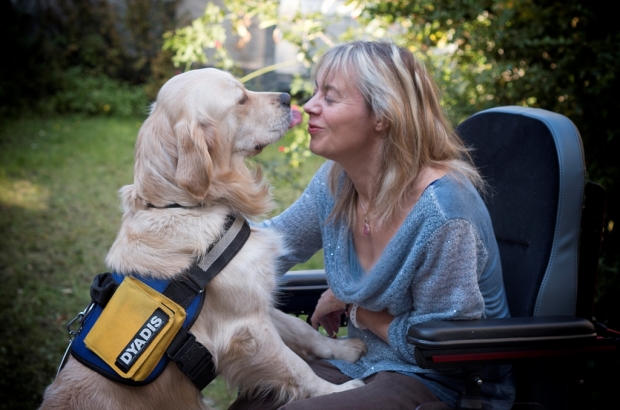- Daily & Weekly newsletters
- Buy & download The Bulletin
- Comment on our articles
Assistance dogs learn to lend a helping paw
A vigilant guardian, a helping hand, a constant companion: assistance dog June is the best thing to have happened to Muriel in years.
The 46-year-old from Dilbeek, Flemish Brabant, has had multiple sclerosis for 15 years, a condition that has left her hemiplegic, meaning she can’t use the left side of her body. She and three-year-old June (pictured together) adopted each other six months ago. It’s a decision that has changed Muriel’s life.
“Day to day, June helps me get into bed and brings me objects I’ve dropped,” she explains. “If I fall, she knows she has to bring me an emergency phone so I can call for help, and she warns me if she thinks intruders are trying to get into the house. She makes me feel much safer, and I know I can count on her.”
The two were brought together by Dyadis, a national charity that trains and funds assistance dogs for people with illnesses and disabilities that restrict their mobility. The idea is to increase a person’s autonomy and enable them to live independently, through training the dogs to carry out a variety of practical tasks around the house and outside.
That might be helping someone out of bed or out of a shirt, fetching objects from another room, collecting the post, picking items off the supermarket shelves, opening doors or cupboards, switching on lights, even pulling washing out of the machine and into a basket. They are also taught to fetch help if their master needs it, from neighbours or passers-by.
Off to school
And of course, they offer company. “The love of a dog is something incredible. June is the best thing that’s happened to me in recent years,” Muriel says. “She gives me so much affection, and she never gets tired of cuddles and being stroked. We’re very close; she’s a part of me. She’s always by my side to check I’m OK.”
Dyadis, based in Woluwe-Saint-Pierre in Brussels, trains about 10 assistance dogs each year, and the process takes two years per dog. They choose puppies from approved breeders, and, aged two months, the young dogs are sent to live with “puppy-walkers”. These are volunteer families or individuals who spend up to 18 months socialising the dogs and getting them used to normal daily activities both at work and at home.
In theory, anyone can be a puppy-walker, explains Dyadis spokesperson Danny Vancoppernolle. Realistically, though, it has to be someone who can spend time with the dog; leaving the dog alone for 12 or more hours a day isn’t going to help it prepare for a life assisting an owner.
“Some of our volunteers take the dog to work,” he says. “Others work part-time, some live alone, some are retired. Some are disabled themselves, but they do it to help others. We pay for everything; it’s your time that we want.”
Puppy-walkers go with their charges to weekly group lessons, for basic training and so that the dogs can socialise. When they’re 18 months old, the dogs go into a kind of canine boarding school, arriving on a Monday morning for a week of more specialised training, and leaving on Friday evening to spend the weekend with a foster family.
When the training is complete, there’s a graduation ceremony, before the masters and dogs set off on their new lives together. Dyadis staff stay in touch to provide support when it’s needed.
Inseparable companions
One volunteer puppy-walker who gets round a hectic professional life by taking her dog to work with her is Carla Dejonghe of Open VLD, a member of the Brussels parliament. She and Lotus are a familiar sight around the city. This is Dejonghe’s second time looking after a Dyadis puppy; the first, Itch, has been placed with a new master.
“I take Lotus with me in the car, we take the metro, tram, bus, we go shopping together… she’s not afraid of those things,” Dejonghe says. “The dogs have to get used to being with someone all the time and learning all these different aspects of life.”
What are the benefits of being a puppy-walker? “You know they will soon be helping someone who really needs them,” she says. “When I see Itch’s new owner, he looks at Itch, and he almost starts to cry because he’s so happy to have him.”
But a puppy-walker’s time is temporary, which “is sad in a way,” she says, “because you love the dogs and they have to leave you. But seeing how much he is loved and needed makes it easier”.
Dyadis mostly works with labradors and golden retrievers, Vancoppernolle explains. “They love to retrieve! As an assistance dog, they have to pick things up and bring them to someone, and as a breed, that’s what they’re programmed to do.”
They’re also naturally very friendly, he says. “They like all different kinds of people. Some breeds only like one kind of master, or only one person. They don’t want to work for everyone. But labradors don’t care. They’re always eager to work.”
The waiting list for a dog is one to two years. And of course, having an assistance dog is not the answer for everyone. “A lot of people don’t understand that a dog is a living animal,” says Vancoppernolle. “It’s not a robot, it can’t do everything, it can’t work all the time, it needs a dog life too. It smells, it sheds hair, and it can’t wash the dishes. But it’s wonderful for people who like dogs.”
Photo courtesy Dyadis









